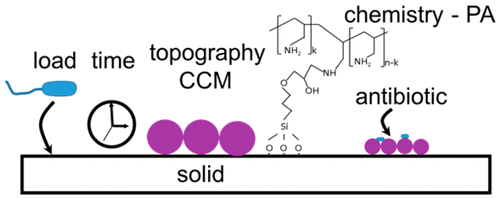当前位置:
X-MOL 学术
›
ACS Biomater. Sci. Eng.
›
论文详情
Our official English website, www.x-mol.net, welcomes your feedback! (Note: you will need to create a separate account there.)
Effects of Colloidal Crystals, Antibiotics, and Surface-Bound Antimicrobials on Pseudomonas aeruginosa Surface Density
ACS Biomaterials Science & Engineering ( IF 5.8 ) Pub Date : 2017-12-15 00:00:00 , DOI: 10.1021/acsbiomaterials.7b00799 Htwe Mon 1 , Yow-Ren Chang 1 , A. L. Ritter 1 , Joseph O. Falkinham 2 , William A. Ducker 1
ACS Biomaterials Science & Engineering ( IF 5.8 ) Pub Date : 2017-12-15 00:00:00 , DOI: 10.1021/acsbiomaterials.7b00799 Htwe Mon 1 , Yow-Ren Chang 1 , A. L. Ritter 1 , Joseph O. Falkinham 2 , William A. Ducker 1
Affiliation

|
We examined the effect of a crystalline layer of silica particles in the size range 0.5–4 μm on the adsorption and surface growth of Pseudomonas aeruginosa. Growth on these colloidal crystal monolayers (CCMs) was compared to growth on a flat plate of silica. All surfaces were coated with a thin film of silica to provide chemical uniformity of the different topographies. The results showed that the CCM reduces the density of colony forming units (CFU) on the solid by 99–99.9% when the suspension load was 103 CFU. We also examined the interaction between the CCM and either antibiotics or a chemically bound antimicrobial. The addition of 20 μg/mL tobramycin after an initial 24 h growth period caused a further decrease in CFU counts of about 99–99.9% for all topographies. The percentage reduction as a result of the antibiotics was similar for all topographies, which suggested that there was no particular synergy between the topography and antibiotics. On the other hand, the additive nature of the two effects suggested promise for clinical studies: the large percentage reduction in CFU density on addition of the antibiotic to a flat surface was maintained on the topography, even starting from a much lower CFU density. A similar result was obtained for the combination of CCM and a covalently bound layer of antimicrobial poly(allylamine hydrochloride) (PAH). The PAH reduced the CFU, and the CCM caused a further reduction; the two factors behaved approximately independently. Overall the CCM was found to be very effective at reducing the density of adsorbed P. aeruginosa both with and without the additional reductions caused by antibiotics or surface-bound antimicrobials.
中文翻译:

胶体晶体,抗生素和表面结合抗菌剂对铜绿假单胞菌表面密度的影响
我们检查了大小为0.5–4μm的二氧化硅颗粒结晶层对铜绿假单胞菌的吸附和表面生长的影响。将这些胶体晶体单层(CCM)上的生长与二氧化硅平板上的生长进行了比较。所有表面均涂有二氧化硅薄膜,以提供不同形貌的化学均匀性。结果表明,当悬浮负荷为10 3时,CCM使固体上的菌落形成单位(CFU)密度降低了99–99.9%。CFU。我们还检查了CCM与抗生素或化学结合的抗菌素之间的相互作用。在最初的24 h生长期后,添加20μg/ mL妥布霉素导致所有地形的CFU计数进一步降低约99–99.9%。对于所有地形而言,抗生素导致的减少百分比相似,这表明地形和抗生素之间没有特别的协同作用。另一方面,这两种作用的累加性质表明临床研究有望:即使从低得多的CFU密度开始,在地形上将抗生素添加到平坦表面后CFU密度的大百分比降低仍然保持。对于CCM和抗微生物聚烯丙胺盐酸盐(PAH)的共价结合层的组合,也获得了相似的结果。PAH降低了CFU,而CCM导致了进一步的降低;这两个因素的表现大致独立。总体而言,发现CCM在降低吸附密度方面非常有效铜绿假单胞菌同时具有和不具有由抗生素或表面结合的抗生素引起的额外减少。
更新日期:2017-12-15
中文翻译:

胶体晶体,抗生素和表面结合抗菌剂对铜绿假单胞菌表面密度的影响
我们检查了大小为0.5–4μm的二氧化硅颗粒结晶层对铜绿假单胞菌的吸附和表面生长的影响。将这些胶体晶体单层(CCM)上的生长与二氧化硅平板上的生长进行了比较。所有表面均涂有二氧化硅薄膜,以提供不同形貌的化学均匀性。结果表明,当悬浮负荷为10 3时,CCM使固体上的菌落形成单位(CFU)密度降低了99–99.9%。CFU。我们还检查了CCM与抗生素或化学结合的抗菌素之间的相互作用。在最初的24 h生长期后,添加20μg/ mL妥布霉素导致所有地形的CFU计数进一步降低约99–99.9%。对于所有地形而言,抗生素导致的减少百分比相似,这表明地形和抗生素之间没有特别的协同作用。另一方面,这两种作用的累加性质表明临床研究有望:即使从低得多的CFU密度开始,在地形上将抗生素添加到平坦表面后CFU密度的大百分比降低仍然保持。对于CCM和抗微生物聚烯丙胺盐酸盐(PAH)的共价结合层的组合,也获得了相似的结果。PAH降低了CFU,而CCM导致了进一步的降低;这两个因素的表现大致独立。总体而言,发现CCM在降低吸附密度方面非常有效铜绿假单胞菌同时具有和不具有由抗生素或表面结合的抗生素引起的额外减少。



























 京公网安备 11010802027423号
京公网安备 11010802027423号